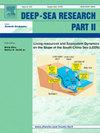Introduction to the Emperor Seamount Chain studies
IF 3
3区 地球科学
Q2 OCEANOGRAPHY
Deep-sea Research Part Ii-topical Studies in Oceanography
Pub Date : 2025-05-22
DOI:10.1016/j.dsr2.2025.105486
引用次数: 0
Abstract
Seamounts are of interest to the scientific community as they occupy a significant part of the ocean floor area and are areas of high biodiversity and productivity. The Hawaiian-Emperor Chain, formed by the Hawaiian mantle plume, is crucial for understanding of the lithospheric plates’ movement in the past. The chain is the longest contiguous chain of islands, guyots and seamounts in the world, whose edges are located in contrasting climatic and biogeographic zones. It may provide stepping stones for dispersal of deep-sea fauna and serve as their refugia, as well as containing commercial resources. The geological features, plankton and fish stocks of this area have been studied since the 1970s, but bottom systems are poorly studied. With the development of deep-sea surveys and the use of ROVs, the bottom communities of the seamounts in the North Pacific and the Emperor Chain have been studied over the last 10 years.
Results
of three research cruises to the area performed in 2019 and 2021 are presented. Numerous new faunistic and biogeographic findings, including the biogeographic boundary between North Pacific and Central Pacific assemblages of species, are made. The feeding modes of the deep-sea corals in the Emperor Chain were surveyed. New data regarding high vertical mixing rates in the area (using Sr isotopes ratio) and possible influence of Aeolian dust input from Asia into the area were obtained. Although seamounts were not previously considered important regions for methane production, substantial methane generation at the Emperor Chain area was discovered. Given the large number of seamounts in the ocean, the global methane budget should be reconsidered.
帝山链概论研究
海山是科学界感兴趣的地方,因为它们占据了海底面积的很大一部分,是生物多样性和生产力很高的地区。夏威夷-皇帝链是由夏威夷地幔柱形成的,对于理解过去岩石圈板块的运动至关重要。这条链是世界上最长的岛屿、土丘和海底山的连续链,其边缘位于不同的气候和生物地理区域。它可以为深海动物群的扩散提供踏脚石和避难所,同时也蕴藏着商业资源。自20世纪70年代以来,人们对该地区的地质特征、浮游生物和鱼类资源进行了研究,但对海底系统的研究很少。随着深海调查的发展和rov的使用,近10年来人们对北太平洋海底山和皇帝链的海底群落进行了研究。本文介绍了2019年和2021年对该地区进行的三次研究巡航的结果。许多新的动物和生物地理发现,包括北太平洋和中太平洋物种组合之间的生物地理边界。对英皇链的深海珊瑚的摄食方式进行了调查。获得了该地区高垂直混合率(利用Sr同位素比值)和亚洲风沙输入可能影响的新数据。虽然海山以前并不被认为是重要的甲烷生产区域,但在皇帝链地区发现了大量的甲烷生成。考虑到海洋中有大量的海底山,全球甲烷收支应该重新考虑。
本文章由计算机程序翻译,如有差异,请以英文原文为准。
求助全文
约1分钟内获得全文
求助全文
来源期刊
CiteScore
6.40
自引率
16.70%
发文量
115
审稿时长
3 months
期刊介绍:
Deep-Sea Research Part II: Topical Studies in Oceanography publishes topical issues from the many international and interdisciplinary projects which are undertaken in oceanography. Besides these special issues from projects, the journal publishes collections of papers presented at conferences. The special issues regularly have electronic annexes of non-text material (numerical data, images, images, video, etc.) which are published with the special issues in ScienceDirect. Deep-Sea Research Part II was split off as a separate journal devoted to topical issues in 1993. Its companion journal Deep-Sea Research Part I: Oceanographic Research Papers, publishes the regular research papers in this area.

 求助内容:
求助内容: 应助结果提醒方式:
应助结果提醒方式:


